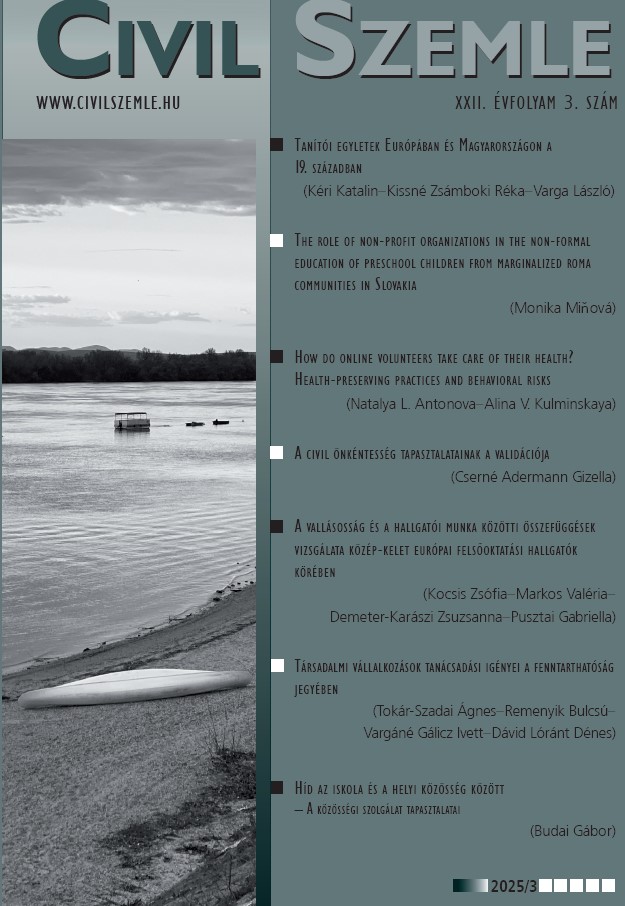A Bridge Between School and Local Community
Experiences of Community Service
Abstract
This study explores the third mission activities of secondary schools in Dunaújváros, with a particular focus on School Community Service Initiatives (SCSI). School community service refers to individual or group activities carried out within an organized framework, free of financial gain, and intended to benefit the local community. These activities fall within eight legally defined areas. According to Section 6 of the 2011 National Public Education Act, students must complete fifty hours of community service as a prerequisite for graduation. This requirement holds both educational and social significance. The aim of this research is to present the community service programs implemented by secondary schools in Dunaújváros, highlighting their impact on both students and the local community. The study focuses on the period between 2014 and 2024. It examines the types of activities carried out as part of school community service, as well as students’ engagement with their local communities and the pedagogical value of these programs. The analysis considers the organizational frameworks supporting community service, the role of teachers, and the nature of collaborations with local civil society organizations. The findings indicate that community service not only fulfills formal graduation requirements but also fosters social responsibility and empathy among students. Furthermore, these programs strengthen the connection between schools and local communities, contributing to the success of third mission initiatives. The results support the conclusion that well-structured and pedagogically guided community service programs yield long-term benefits for both students and the communities they serve.
References
Benneworth, P. et al. (2010). Universities and Regional Innovation: Regional Innovation Strategies and the Third Mission of Universities.
Benneworth, P., & Jongbloed, B. (2010). Who matters to universities? A stakeholder perspective on humanities, arts and social sciences valorisation. Higher Education, 59(5), pp. 567–588. https://doi.org/10.1007/s10734-009-9265-2
Bodó, M., Sárosi, T., & Markos, V. (2017). Az iskolai közösségi szolgálat program tanulságai online diákkérdőívek és monitori vizsgálat tükrében. Országos Neveléstudományi Konferencia, Nyíregyházi Egyetem.
Budai, G. (2014). Tanulói és tanulási utak a rendszerváltástól napjainkig. Dunakavics, 2(6), pp. 5–28.
Budai, G. (2015). Információs társadalom iskolái: hagyományos és elektronikus tanulás. Dunakavics, 3(9), pp. 27–42.
Budai, G. (2023). A tudás hasznosítása a munkaerőpiacon. Dunakavics, 11(1), pp. 35–37.
Bursik, M. (2020). Az iskolai közösségi szolgálat társadalmi vetületei. Oktatáskutató Intézet Tanulmánykötete.
Erikson, E. H. (2002). Gyermekkor és társadalom. Budapest: Osiris Kiadó.
Eyler, J., & Giles, D. E. (1999). Where's the learning in service-learning? San Francisco, CA: Jossey-Bass.
G. Merva, M. (szerk.). (2009). A magyarcserkészet története 1910-től napjainkig. Kiállítási katalógus. Gödöllő: Gödöllői Városi Múzeum.
Kárpáti Á. (2019): Ifjúságsegítő képzések Európában. In Nagy Á. (Szerk.): Egyszer volt, hol nem volt… Az ifjúságsegítő képzés Magyarországon. Kecskemét: Neumann János Egyetem, Iuvenis Ifjúságszakmai Műhely
Matolcsi, Zs. (2013). Iskolai közösségi szolgálat, mint pedagógiai eszköz. Neveléstudomány, 4, pp. 70–83. El
Percy-Smith, B., & Burns, D. (2013). Exploring the role of children and young people as agents of change in sustainable community development. Local Environment, 18(3), pp. 323–339. https://doi.org/10.1080/13549839.2012.729565
Szabó, I., & Veres, Zs. (2019). Közösség és iskola – a harmadik misszió értelmezési lehetőségei a középfokú oktatásban. Neveléstudomány, 7(1), pp. 5–23.



